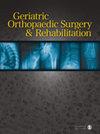The Impact of Triglyceride-Glucose Index Levels During Perioperative Period on Outcomes in Femoral Neck Fracture Patients.
IF 1.6
4区 医学
Q4 GERIATRICS & GERONTOLOGY
引用次数: 0
Abstract
Introduction The objective of the present study is to assess the impact of the triglyceride-glucose index (TyG index) on the prognosis and explore the correlation between the TyG index and all-cause mortality in femoral neck fracture patients. Materials and Methods In this retrospective cohort study, we analyzed the TyG index in the follow-up of femoral neck fracture patients who underwent partial hip prosthesis. The formula of ln [fasting triglycerides (mg/dL) x fasting blood glucose concentration (mg/dL)/2] was used in the calculation of the TyG index. The patients were separated into three categories based on the TyG index. Results It was found that there was a significant correlation between prolonged hospital stay and elevated admission and postoperative TyG index (P = 0.011, P < 0.001, respectively). The Kaplan-Meier survival analysis curves revealed a higher risk of 30-day, 90-day and overall mortality in patients with higher postoperative TyG index levels, categorized by postoperative TyG tertiles (log-rank P < 0.001, P < 0.001 and P = 0.001, respectively). In the multivariate Cox proportional hazard models, higher postoperative TyG index was a significant risk factor for mortality (P = 0.01). The receiver operating characteristic analysis indicated that a postoperative TyG index of 9.01 and above was critical for 30-day mortality (69% sensitivity, 82% specificity and 0.78 area under curve; P < 0.001). Conclusions In our study demonstrate that the TyG index may be useful in identifying individuals at high risk of mortality in patients with femoral neck fractures.围手术期甘油三酯-葡萄糖指数水平对股骨颈骨折患者预后的影响
导言本研究的目的是评估甘油三酯-葡萄糖指数(TyG指数)对股骨颈骨折患者预后的影响,并探讨TyG指数与全因死亡率之间的相关性。材料与方法在这项回顾性队列研究中,我们分析了接受部分髋关节假体手术的股骨颈骨折患者随访期间的TyG指数。TyG指数的计算公式为ln[空腹甘油三酯(mg/dL)x空腹血糖浓度(mg/dL)/2]。结果发现,住院时间延长与入院和术后TyG指数升高之间存在显著相关性(P = 0.011,P < 0.001)。卡普兰-米尔生存分析曲线显示,术后TyG指数水平较高的患者术后30天、90天和总死亡率风险较高,按术后TyG三分位数分类(对数秩分别为P < 0.001、P < 0.001和P = 0.001)。在多变量 Cox 比例危险模型中,术后 TyG 指数越高,死亡率越高(P = 0.01)。接受者操作特征分析表明,术后TyG指数达到或超过9.01是30天死亡率的关键因素(灵敏度为69%,特异度为82%,曲线下面积为0.78;P < 0.001)。
本文章由计算机程序翻译,如有差异,请以英文原文为准。
求助全文
约1分钟内获得全文
求助全文
来源期刊

Geriatric Orthopaedic Surgery & Rehabilitation
Medicine-Rehabilitation
CiteScore
3.00
自引率
0.00%
发文量
80
审稿时长
9 weeks
期刊介绍:
Geriatric Orthopaedic Surgery & Rehabilitation (GOS) is an open access, peer-reviewed journal that provides clinical information concerning musculoskeletal conditions affecting the aging population. GOS focuses on care of geriatric orthopaedic patients and their subsequent rehabilitation. This journal is a member of the Committee on Publication Ethics (COPE).
 求助内容:
求助内容: 应助结果提醒方式:
应助结果提醒方式:


